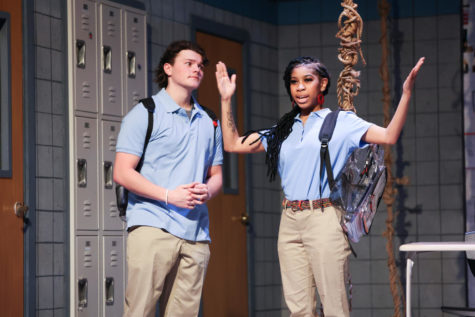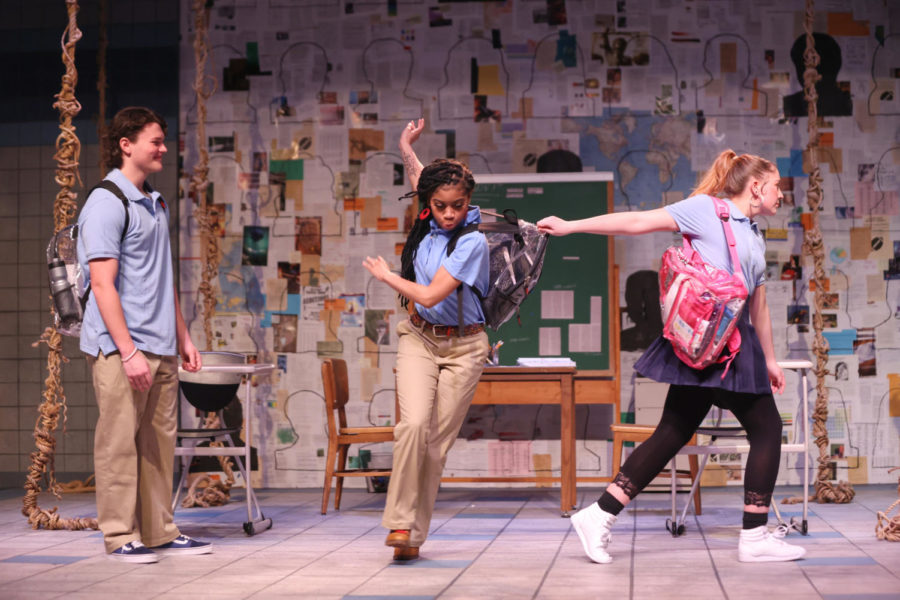‘Blood at the Root’ play explores race, sexuality and justice
UK Theatre presented “Blood at the Root” on Feb. 23-26, 2023, at Briggs Theatre at the University of Kentucky in Lexington, Kentucky. Photo by Mark Cornelison | UK Photo
March 6, 2023
Going to see “Blood at the Root” by Dominique Morisseau in Briggs Theatre took me straight into the heat of the Deep South with how humid it was there.
On Sunday, Feb. 26, the tiny theater was packed. But the busy chatter and body heat couldn’t distract me from the set, especially the tree glowing bright in the far-right corner.
The play immersed me in Deep South Louisiana. It led my fellow audience members and me into a complex story of race, sexuality and the idea of justice and how it tends to get served in communities that are racially divided.
What first interested me about this play was its title. “Blood at the Root” is also a phrase repeated throughout “Strange Fruit,” a haunting and eerie song about the lynchings of African Americans in the South.
Before it became the song that launched Billie Holiday into the national spotlight, it was a poem. The poem was called “Bitter Fruit” and was written by Abel Meeropol.
The concepts throughout “Blood at the Root” were shown through intense dialogue and high-pressure scenes. Difficult conversations were had on stage, and they all lasted with me afterwards.
It was set in Deep South Louisiana at a high school divided by racial tension.
The play is based on the Jena Six. In 2006, a Black student at Jena High School, in Jena, Louisiana, asked their principal for permission to sit under a tree only white students sat under on school grounds.
The day after the Black students asked to sit under the tree, nooses were found hanging from it.
The play reflected the story of this incident and the aftermath of it.

Six students in the play were charged with attempted murder after beating up a white student at school.
The fight was played out for us on stage by an ensemble of silhouettes lit by their phone screens, which were full of text messages and rumors spreading like a wildfire through the school, until we got to see the individuals involved pleading their case.
“Blood at the Root” explores the juxtapositions of race and sexuality through the conservative white gaze. The incident occurred because homophobic and racial slurs were exchanged between the boys, and it resulted in a physical altercation in the aftermath of the noose incident.
The heated tension bubbling and referenced throughout the play came to a head when the sister of one of the boys arrested visited the boy who her brother beat up and asked him to drop the charges.
This was the most intense scene for me in the play, and the actor and actress on stage did such an amazing job — I was almost brought to tears.
In the sister’s pleading for the charges against her brother to be dropped, the intricate way in which marginalized communities are pitted against one another and the warped way everyone sees justice is put under a microscope.
Both poor and gay in a conservative southern town, the white student on the receiving end of the beating is angry that he was targeted because of his sexuality and, rightfully so, wants justice.
The six Black teens charged with attempted murder want justice, too. Young Black men are routinely disenfranchised by the policing system and statistically receive harsher charges or longer sentencing. Although they were wrong for beating him up, attempted murder is a stretch, and their youth was hanging in the balance.
This could take their lives away like so many other Black men that have been incarcerated or policed in our country during their teen years, and Black families are left picking up the pieces from a shattered incarceration system.
I didn’t know what to expect when I bought tickets to see this play, but I was also happy to see the dilemmas of the journalism world thrust into the spotlight as well. One of the characters oversees their high school newspaper, and also happens to be Black and very distant from the racial incidents playing out at his school.
Meanwhile, his white female counterpart wants to tell the story to the best of her ability, even if it means standing with the Black students in their rage over the multiple injustices depicted throughout the play.
This play left me thinking about how far we’ve come in American society in our battle to acknowledge, reform and combat systemic racism.
It also made me wonder what justice means to different people and how the act of it being carried out impacts entire communities sometimes — whether it’s deserved or not, especially in marginalized communities.
If this play ever makes its way back to UK, students should be sure to go see it.


























































































































































